How to operate relay line block equipment/en
This tutorial will explain how to operate the three most common Polish line block types. In this thread I refer to relay interlockings with a control table. Currently Będzin, Łazy Łc, Zawiercie and Dąbrowa Górnicza Wschodnia are equipped with such interlockings. There will be a separate tutorial for electronic interlockings. I describe the operation and functionality here in quite some detail, so the texts are long. It is best to use this tutorial when you are logged into a signal box. That way you can try out the functions directly.
PLEASE MIND: This tutorial was just translated from the German version that I have made. I used Deepl in most places and adjusted some wordings and vocabulary. I had a hard time to translate the detailled technical and specific terms from Polish/German to English. This is the reason why this tutorial might seem odd in some places. I am open for feedback helping me to improve this tutorial for the English speaking.
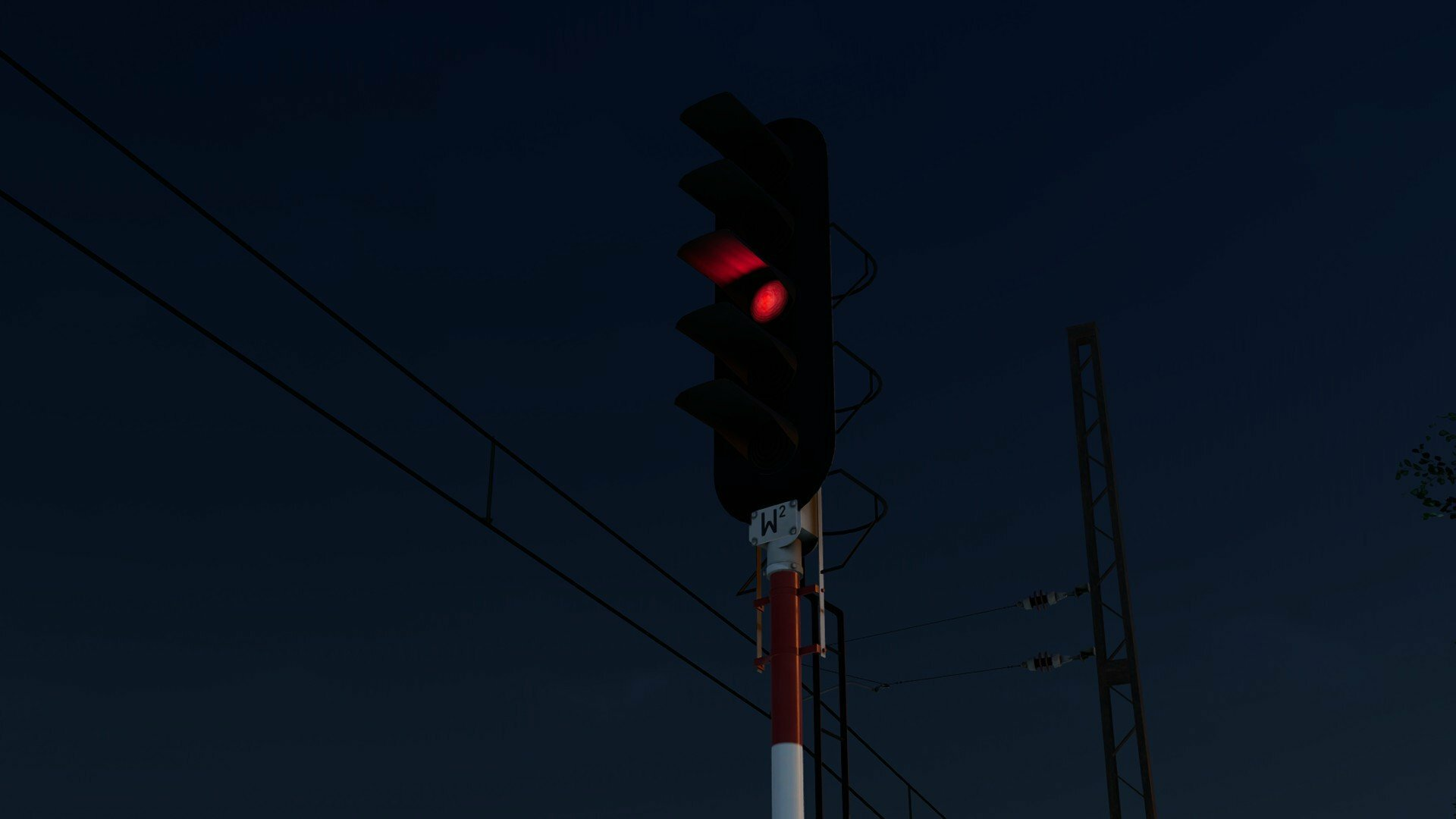
Purpose of the line block
The line block is a type of interface between two neighbouring interlockings. Within the station, the points and track sections are secured with the help of the routes and are brought into dependency with the signals. This is often not practical for the open line between interlockings, as there are usually no points there in the first place. Usually, there is no shunting and the trains do not change direction in these sections. The technology there can be designed to be somewhat less complex. Therefore, the line block is used.
An important difference to the routes is the following: Routes are mostly within an interlocking and especially in the relay interlocking often independent of the neighbouring interlockings. The line block, however, is almost always intended to connect two interlockings in their control systems. The purpose of the line block is to ensure that a moving train on the open line is not endangered by an oncoming or following train. The line block is thus intended to prevent a train from entering a section of track that is already under occupation of another train.
Types of line block
At the moment, three different types of line block are simulated in SimRail's relay interlockings. The whole thing is divided as follows:
non-automatic line block
- Relay block type C
- line block type Eap
automatic line block
- Eac type line block
Non-automatic line block - półsamoczynna blokada liniowa (PBL)
The non-automatic line block is an umbrella term for all line block designs that require the involvement of the signaller. In some cases, however, non-automatic systems can be partially or fully automated. The line block of design C does never operate automatically, here each individual operating step must be carried out manually. The Eap type is a line block that operates partially automatically.
In contrast to the automatic counterpart, a train integrity/line clearance check must be carried out on lines with non-automatic line block in most cases after each train movement. Depending on the level of automation of the system, the clearance check by the dispatcher may be unnecessary. For example, some lines are equipped with a track vacancy detection system with track circuits or axle counters. The train integrity can be determined by observing the tail lamps or tail boards of a passing train and is the most vital part in declaring a line section for clear again. Along a line there may also be manned (posterunek odstępowy, p.o.) or automated blockposts (automaticzny posterunek odstępowy, APO), which are also equipped with line block. Block signals are set up here to increase line capacity.
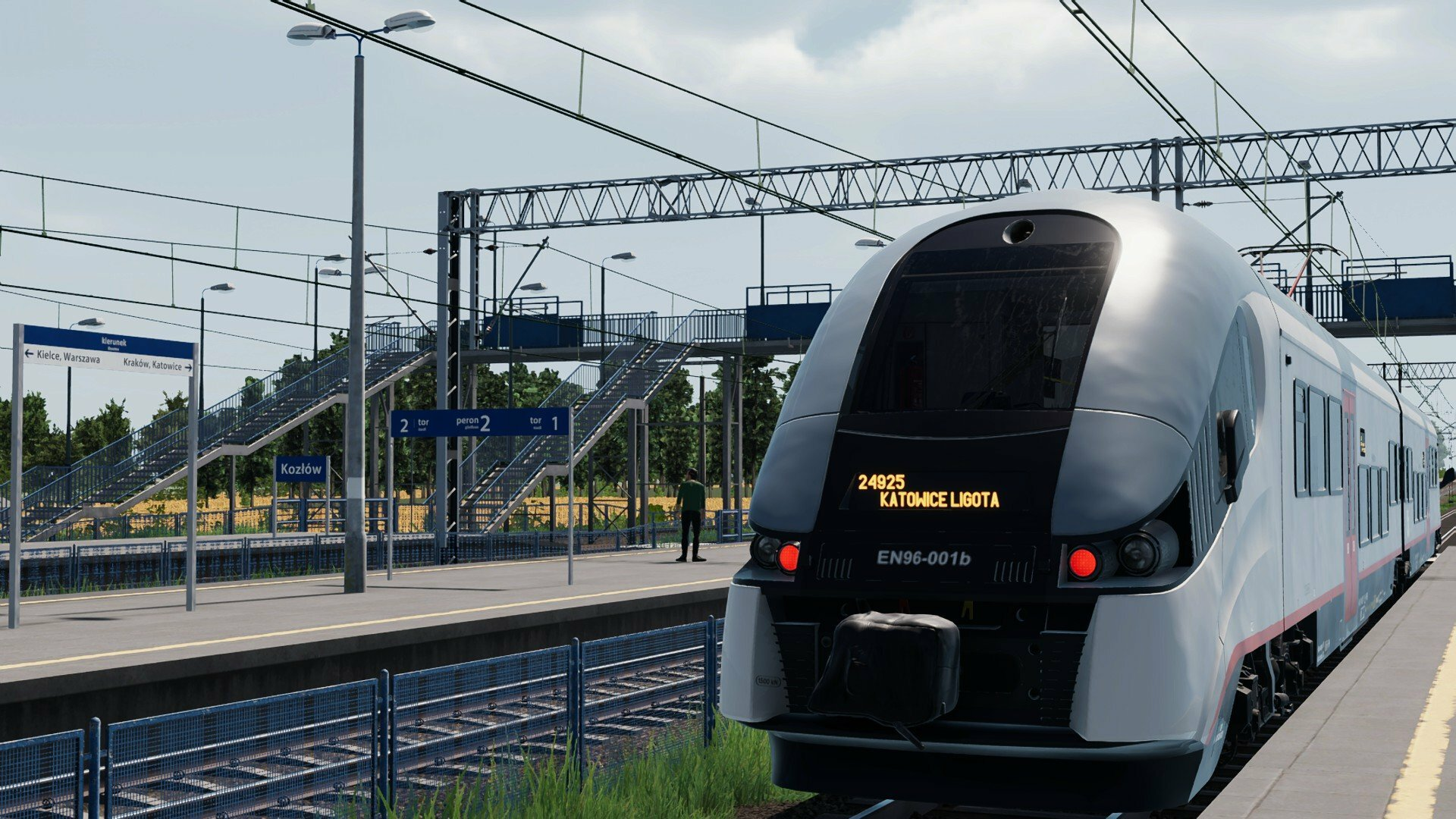
Examples of tail signals. They are placed on the last vehicle of the train. If we can see those, the train did not loose any vehicles along the line. It will allows us to operate buttons in the signal box that will clear the line block again.
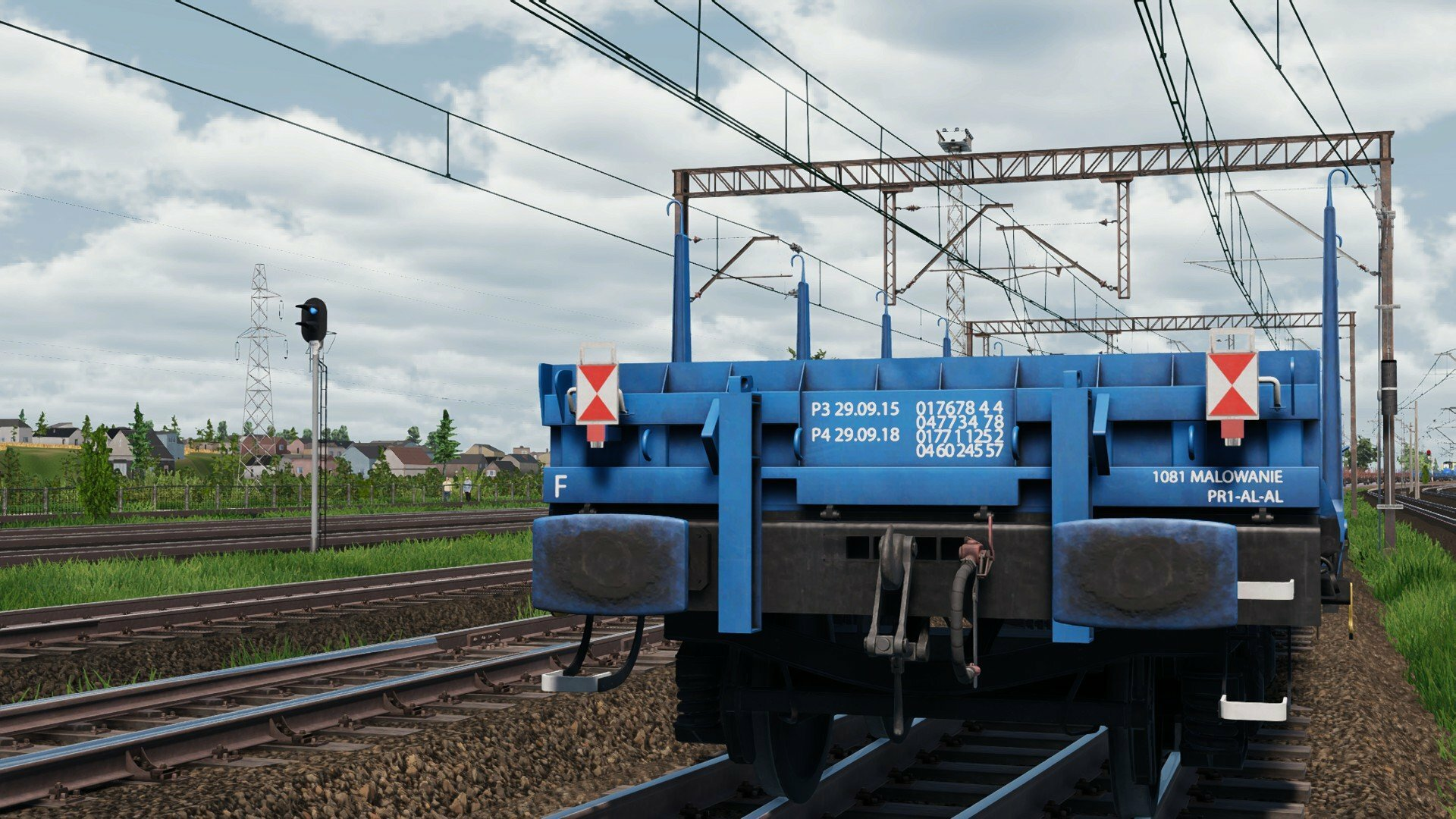
Relay block type C
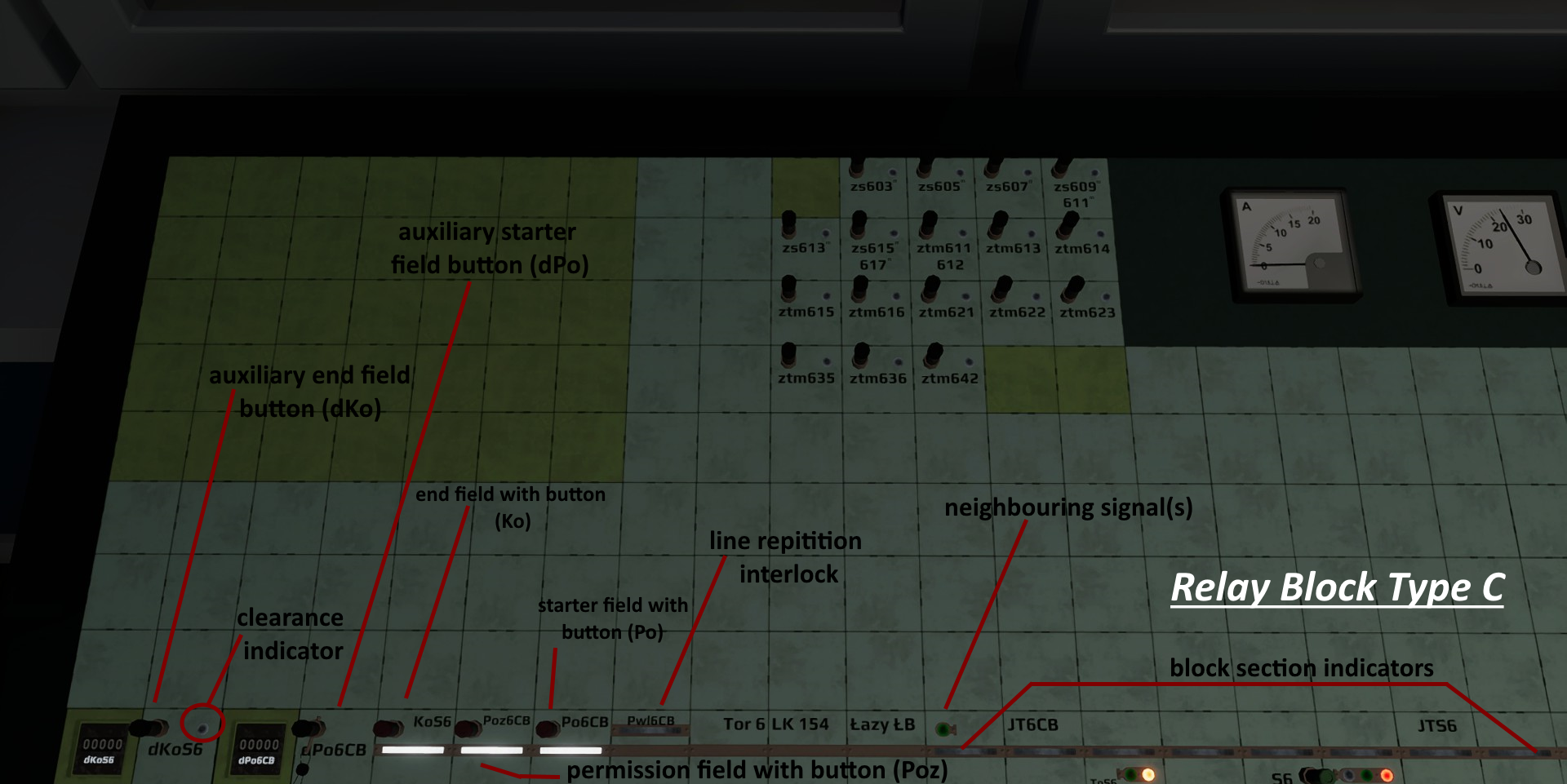
The relay block type C is a non-automatic line block which was developed directly from the classic manual block as it was used in (electro-)mechanical interlockings. Instead of mechanical components, however, all dependencies are realised with relay technology. With this line block, old (electro-)mechanical interlockings can be connected to a relay interlocking without major effort, as the line block equipment in the old, existing interlocking does not have to be completely renewed. The C-type relay block can be equipped with a track vacancy detection system. All operations of this line block must be carried out manually. The block fields in detail: The field block consists of up to three fields per track, which can be arranged either next to or above each other: Permission field (blok pozwolenia, Poz) Starter field (blok początkowy, Po) End field (blok końcowy, Ko).
Example of stacked block fields
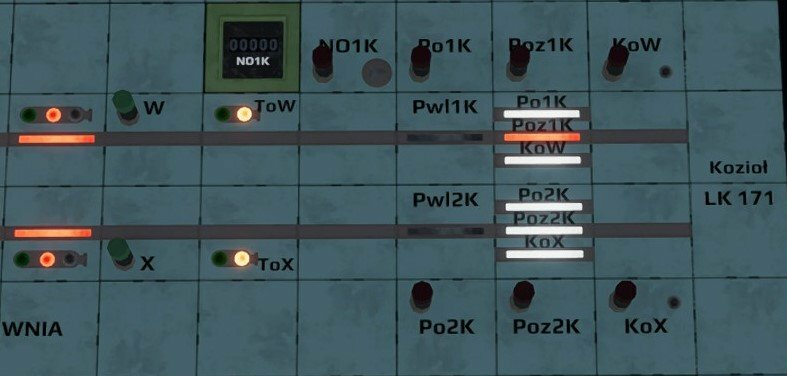
The permission field is set up when a track is used in both directions as scheduled. This is the case for single-track lines and for double-track lines equipped with main signals in both directions. In second case, the instructions for the operation of "NO" and "NP" as described for SBL systems (see below) apply in analogy, in case movements take place on the opposite track. The permission field is also connected to the according permission field of the neighbouring interlocking. If it is blocked (red), the neighbouring signal box may release a train. If the permission field is unblocked (white), we are allowed to release a train. If the permission field is blocked, the exit signals in the direction of the track are held in stop position. Only one signal box can have the permission for one track at a time. The permission field can only be operated when all other block fields are unblocked (white) and line repetition interlock is not in effect. The starter field is connected to the end field of the neighbouring signal box. In default position it is unblocked (white). This means that the track is free of any vehicles. If the starter field is being blocked (red), the line is considered to be occupied. If we operate the starter field in our interlocking, the end field is operated in the neighbouring signal box and vice versa. The end field is connected to the starter field on the neighbouring signal box. Here, too, the default position is unblocked (white) and blocked when the line is occupied (red). As soon as the end field is unblocked, the track is clear again for another train. The block fields are dependent to the signals of the signal boxes in various ways and cannot be operated loosely.
Train running from our signal box to the neighbour's signal box
Before we send a train to a neighbouring signal box, the relay block must be in a certain state:
- All block fields [Poz, Po, Ko] must be unblocked (white)
- the line repetition interlock (Pwl) must not be active (red)
- if present, block section indicators must not show "occupied"
If all these requirements are met, the main signal can be set to clear in the direction of the neighbouring signal box. As soon as the main signal shows "clear", the line repetition interlock becomes effective (Polish: przekaźnika przeciwwtórności liniowej). It prevents two trains in a row from entering the same block section without having the line bock being properly operated in the meantime.
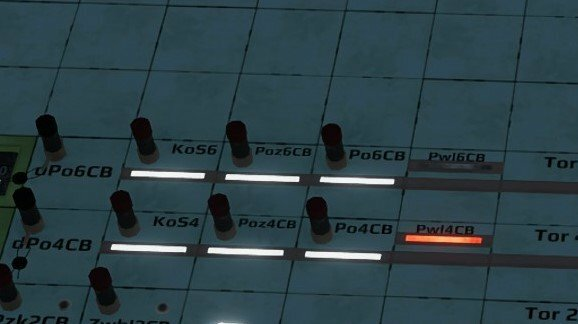
ATTENTION: If the signal is brought back to stop before a train has passed, the line repetition interlock remains active (red). The main signal cannot be set to clear again until a train passed the block section under regular operation of line block equipment. If the train passes the signal showing "clear", it is time to give "the train in section" signal and thus report the line as occupied. The following technical requirements must be met for operating the starter field (Po):
- Main signal has been set to clear
- line repetition interlock is effective (red)
- Main signal has reached the stop position again
Now the Po button can be pressed. The corresponding block field is blocked (red) and the line repetition interlock becomes ineffective.

ATTENTION: If a main signal in the direction of the neighbouring signal box cannot be set to clear, the auxiliary button for the starter field (dPo) must be used! This is important when running on a replacement signal (Sz) or written order.
The operation of dPo will activate the line repetition interlock (Pwl) and will then allow you to operate the starter field (Po), even though your exit signal for this train has not shown a clear position before.
Now that the train is on its way to our neighbour, we wait for the operation of their end field and thus to give the "line clear" signal. This unblocks our starter field (Po) and the line is cleared again to be used by the another train.
Train running from the neighbouring signal box to our signal box
This example takes places in station Dąbrowa Górnicza Wschodnia. The shown line consists of two line tracks and is equipped for left-line running under us of regular main signals. For this reason, Permission fields (blok pozwolenia, Poz) is in place.
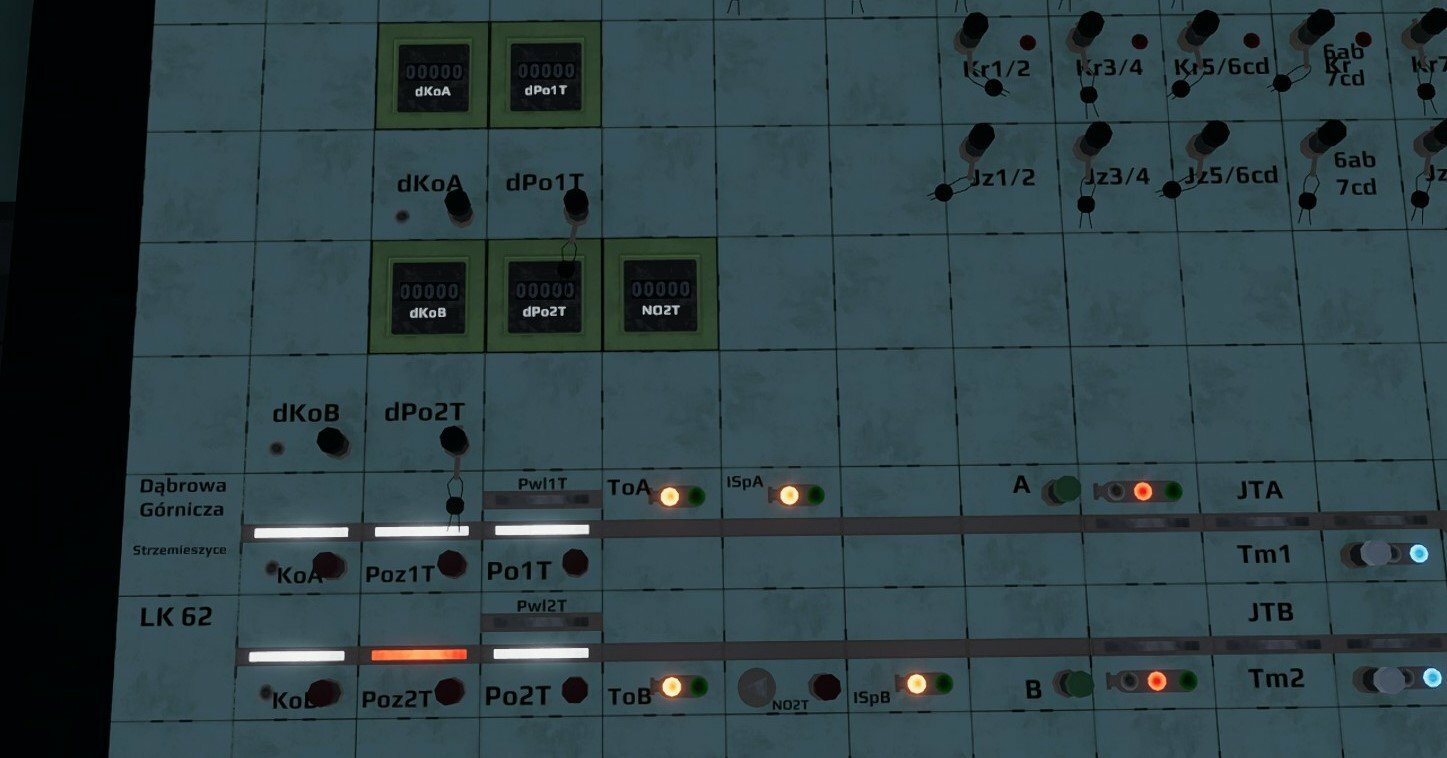
In case we are expecting a train from the neighbouring signal box, our end field (Ko) is blocked (red) after the train has left the neighbouring station.
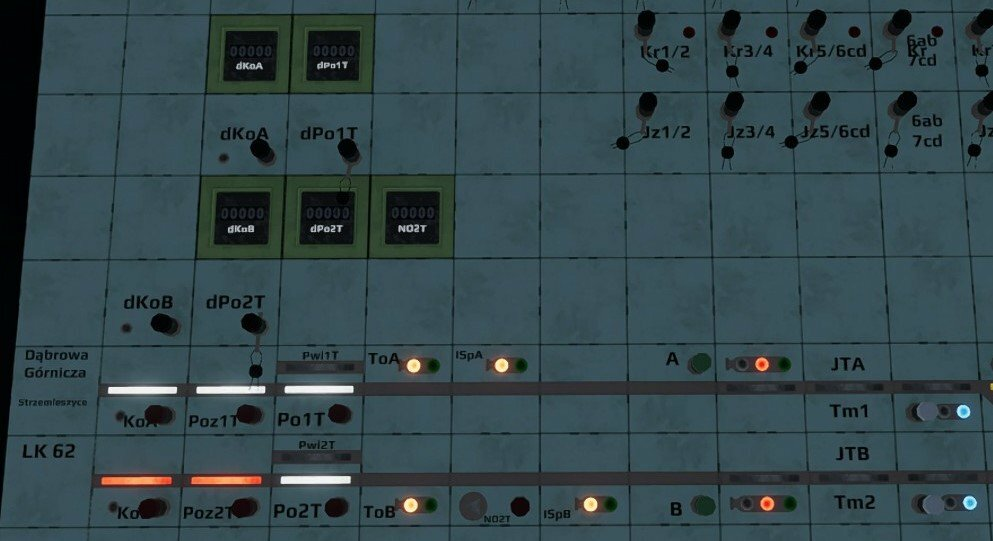
The entry to our station has been set to clear
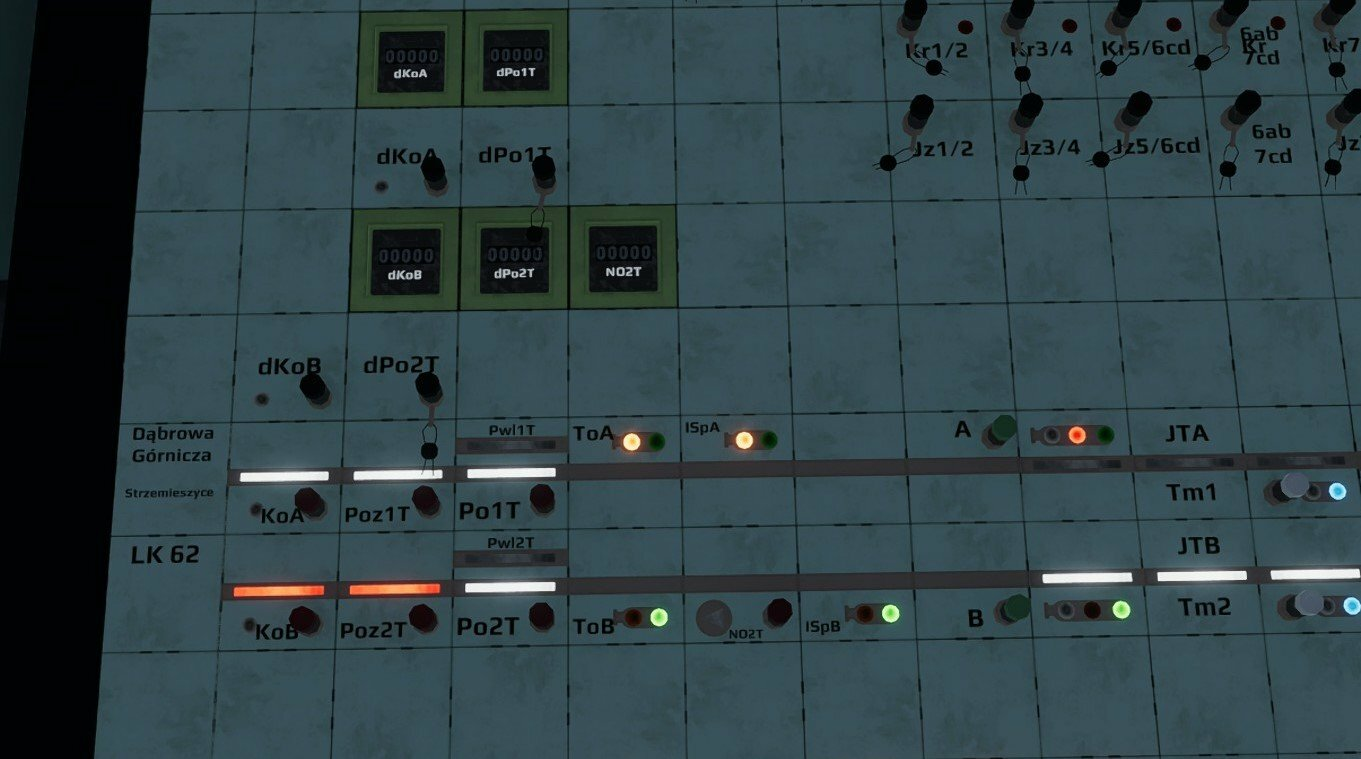
The train has passed our entry signal and sets it back to stop automatically
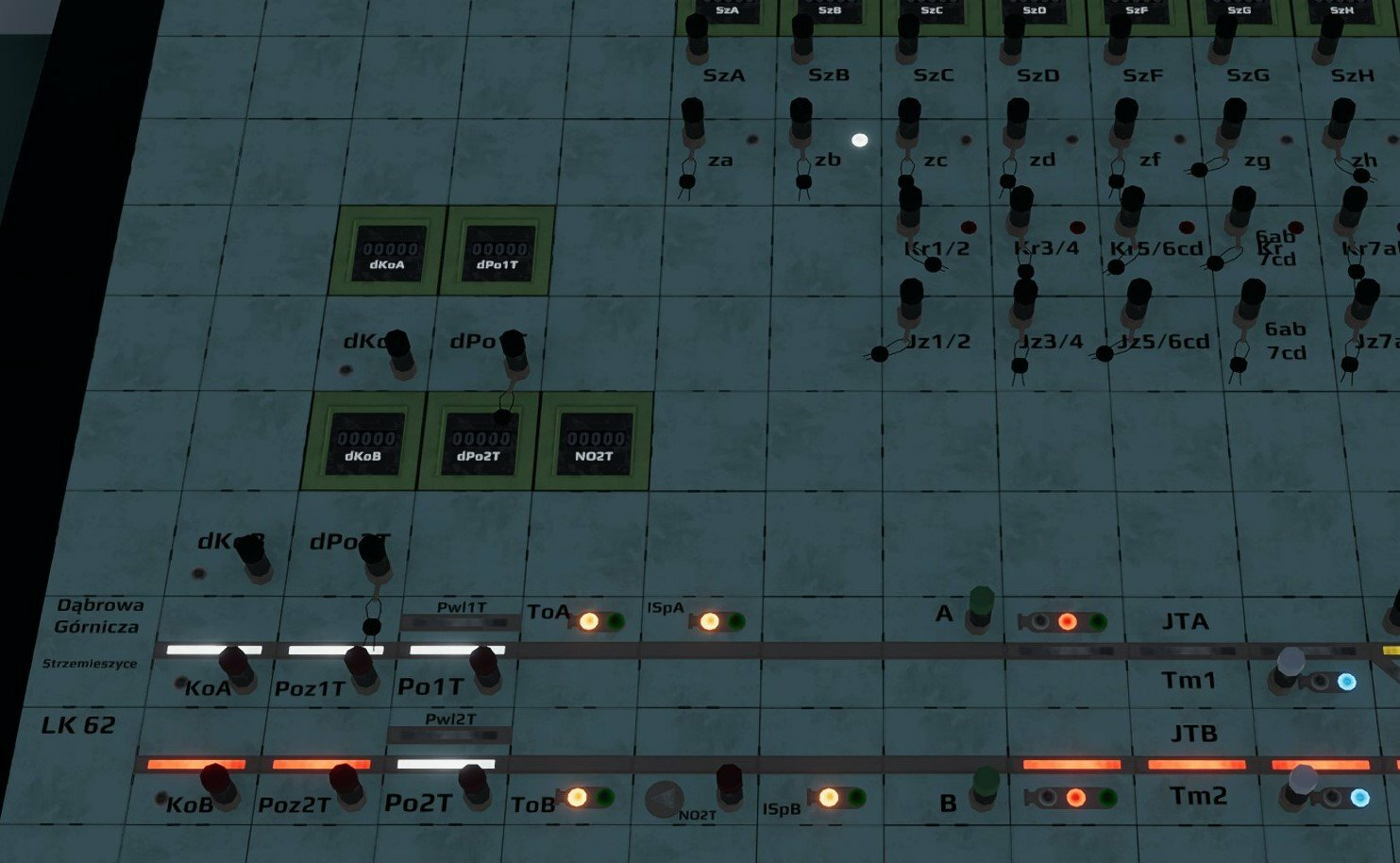
The train now cleared the first track circuit behind the entry signal. Clearance indicator is lit.
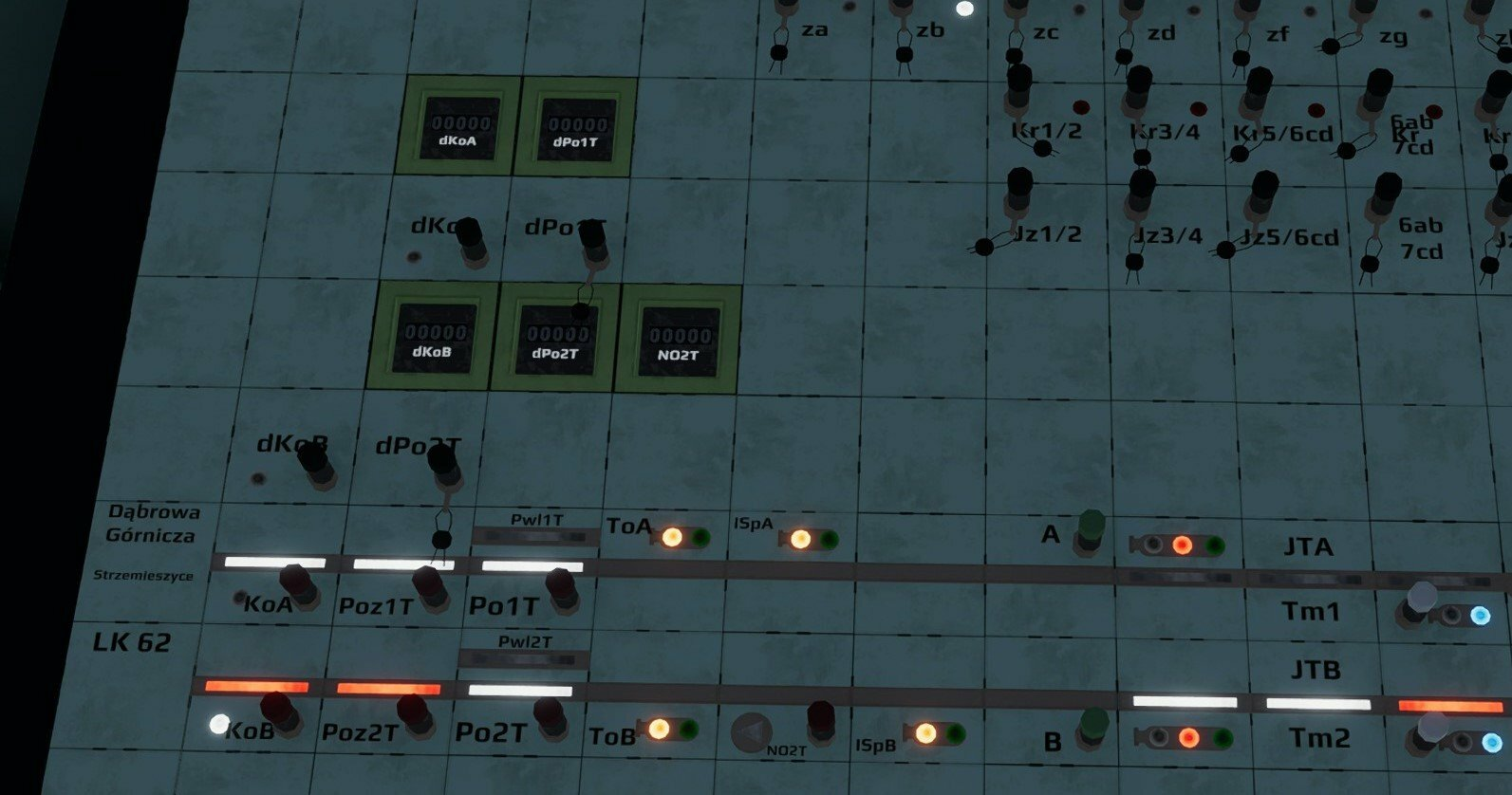
If the train has been through the block section and has passed our entry signal, it is now time to get active, so that we can release the line for the next train. In order to unblock (whiten) the end field (Ko), the following technical requirements are to be met:
- Our entry signal has been set to clear
- Our entry signal has reached stop position again
- if available: block section detectors do not indicate occupation of the track
- The train has cleared the overlap behind the entry signal
- (clearance of the first track section behind our main signal will activate clearance indicator)
- the train has a tail signal
- (the tail signal of the train does not have to be detected if the relay block is equipped with a track vacancy detection system)
- clearance indicator is lit
To send the signal "line clear", the corresponding Ko button is pressed. The end field (Ko) is unblocked and the next train can follow.

ATTENTION: If our entry signal does not reach a clear position and a train is authorized to pass it by written order or substitute signal (Sz), the clearance detector has to be switched on manually! This is done by pulling the button dKo. If the dKo is not operated in this case, the technical requirements for sending the "line clear" signal are not fulfilled and the line will continue to be blocked, even though the train has cleared the track.
Line block type Eap
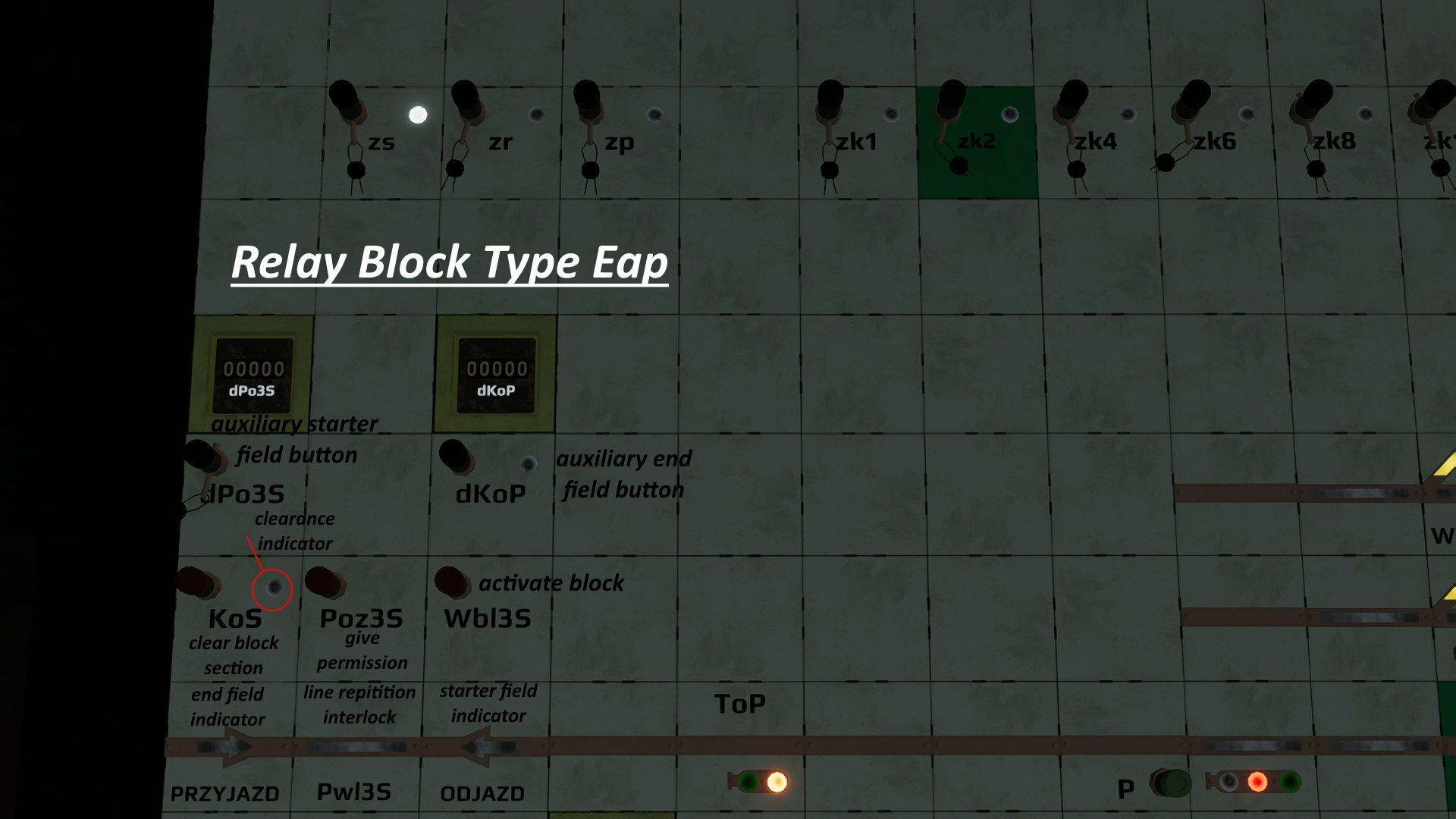
The Eap type line block is a relay block based on the Eac type automatic line block. This Eap line block therefore works partially automated. There are no classical fields any more. Instead, it has two arrow-shaped detectors: A train so-called starter field indicator, pointing away from our station, and a so-called end field indicator, pointing in our direction. Between the two arrows, there is still the line repetition interlock (Pwl), working exactly the same way as in the type C relay block (see above). The Eap block always allows a track to be operated in both ways while being under technical protection, so there will also be "NP" and "NO" buttons where fitted, provided it is a double-track line. Notes for the operation of "NO" and "NP" are as described for SBL installations (see below), provided that movements take place on the opposite track. Optionally, the Eap block can also be equipped with a track vacancy detection system. If there is no train running at the moment, the Eap block is in a neutral state and all indicators are extinguished.
Train running from our signal box to the neighbouring signal box
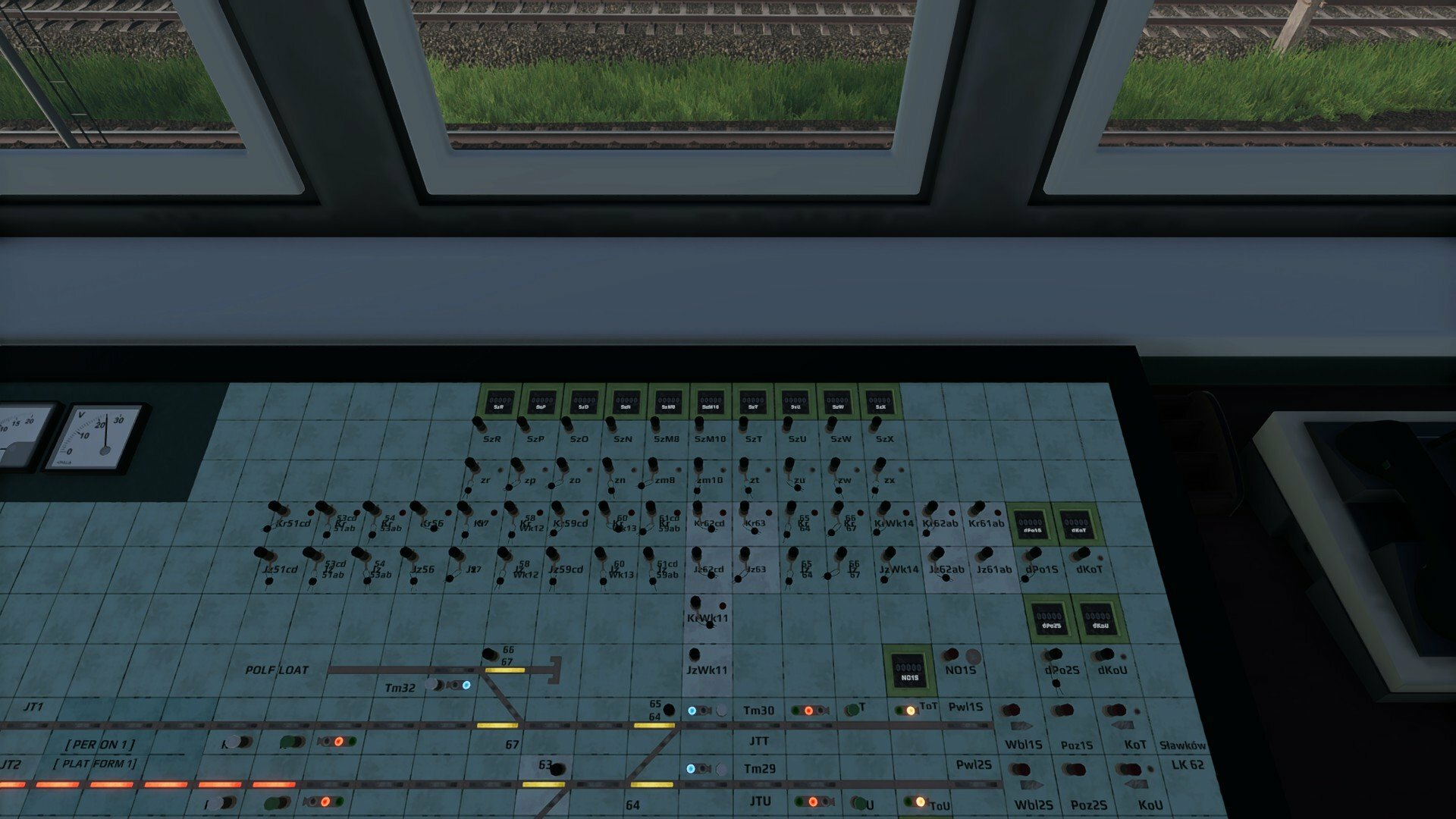
Before we can send a train to the neighbouring signal box, we have to switch on the line block by pushing the "Wbl" button. The starter field indicator starts flashing white. The neighbouring traffic controller must agree to the activation. While the starter field indicator is flashing white, the request to switch on the block can be cancelled by pulling the "Wbl" button.
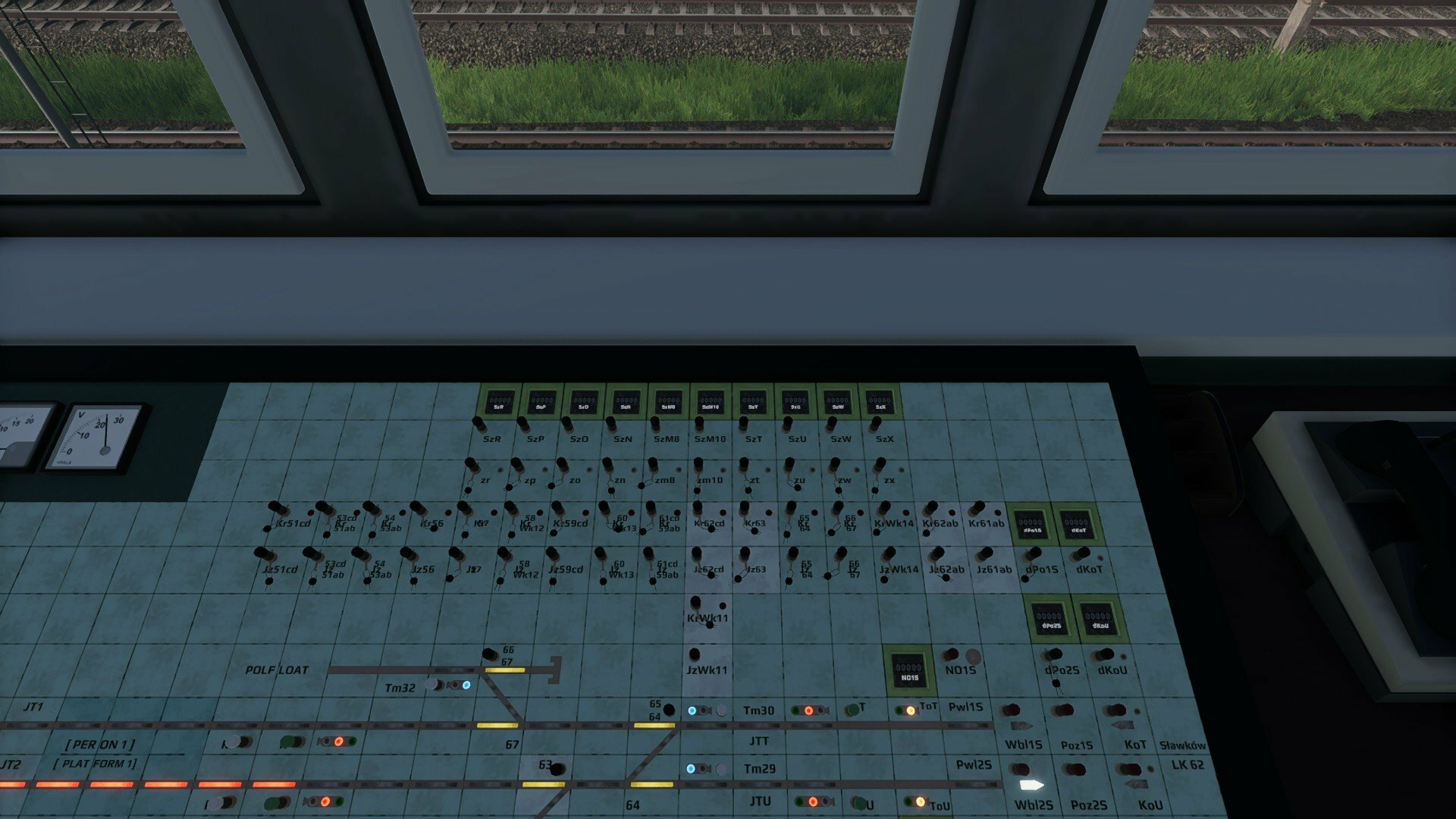
As soon as the neighbouring signalman has given his permission, the starter field indicator changes to steady white light and we can set our exit signal to clear.
If the train is not supposed to run anymore, the activation of the block section can still be cancelled after acception. However, this is only possible if the line repetition interlock has not gone active. First we have to pull the "Wbl" button, then the activation in the neighbouring signal box has to be cancelled as well. As soon as this is successful, the system returns to the neutral default position. But in this case we really want the train to proceed and clear the signal.
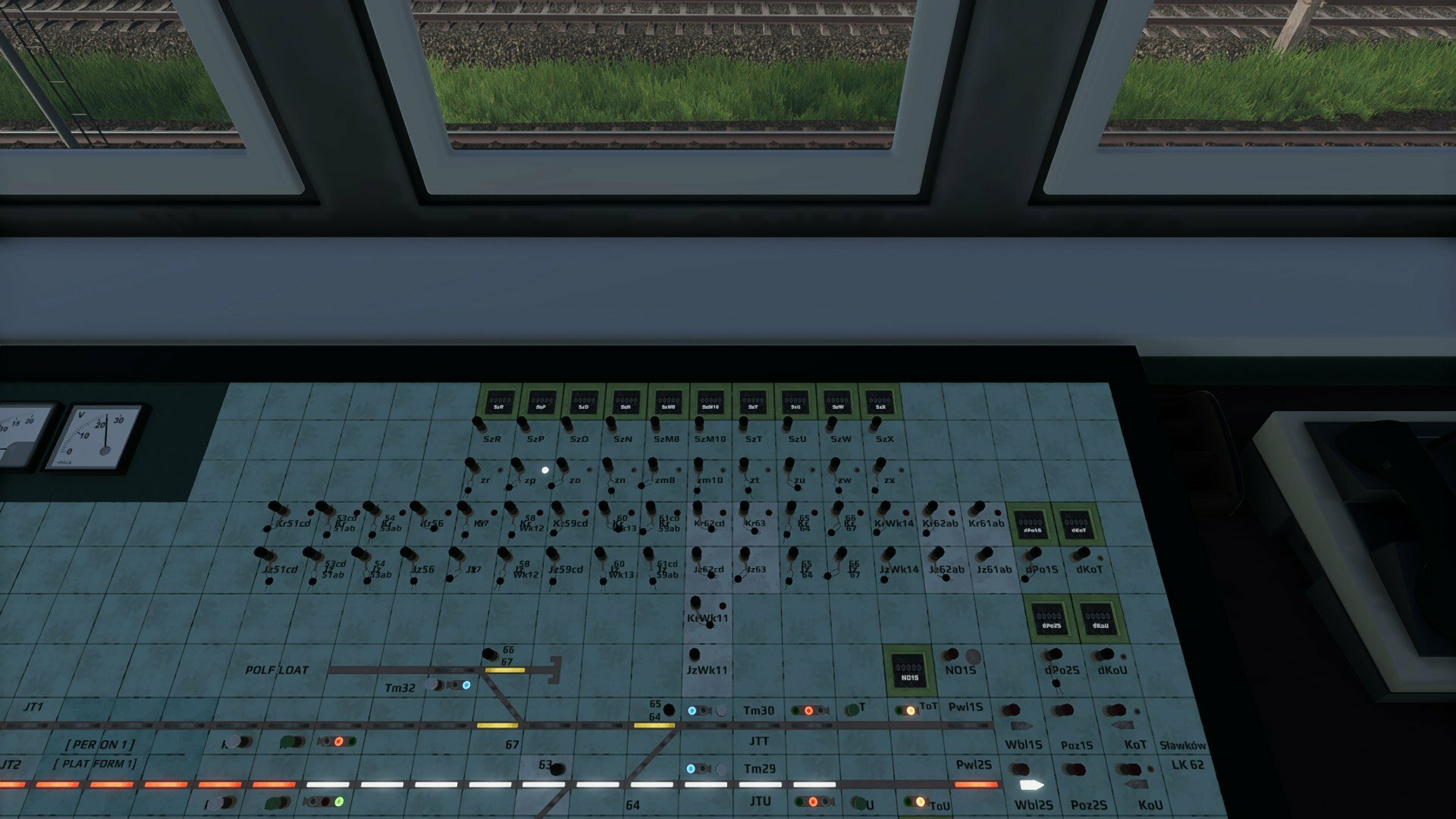
The line repetition interlock (Pwl) becomes effective when our exit signal is in the clear position. It will remain effective when the exit signal is set to stop again manually. If the exit signal is set to stop either by the train or manually by us, the starter field indicator changes to red steady light and the section is considered to be occupied.
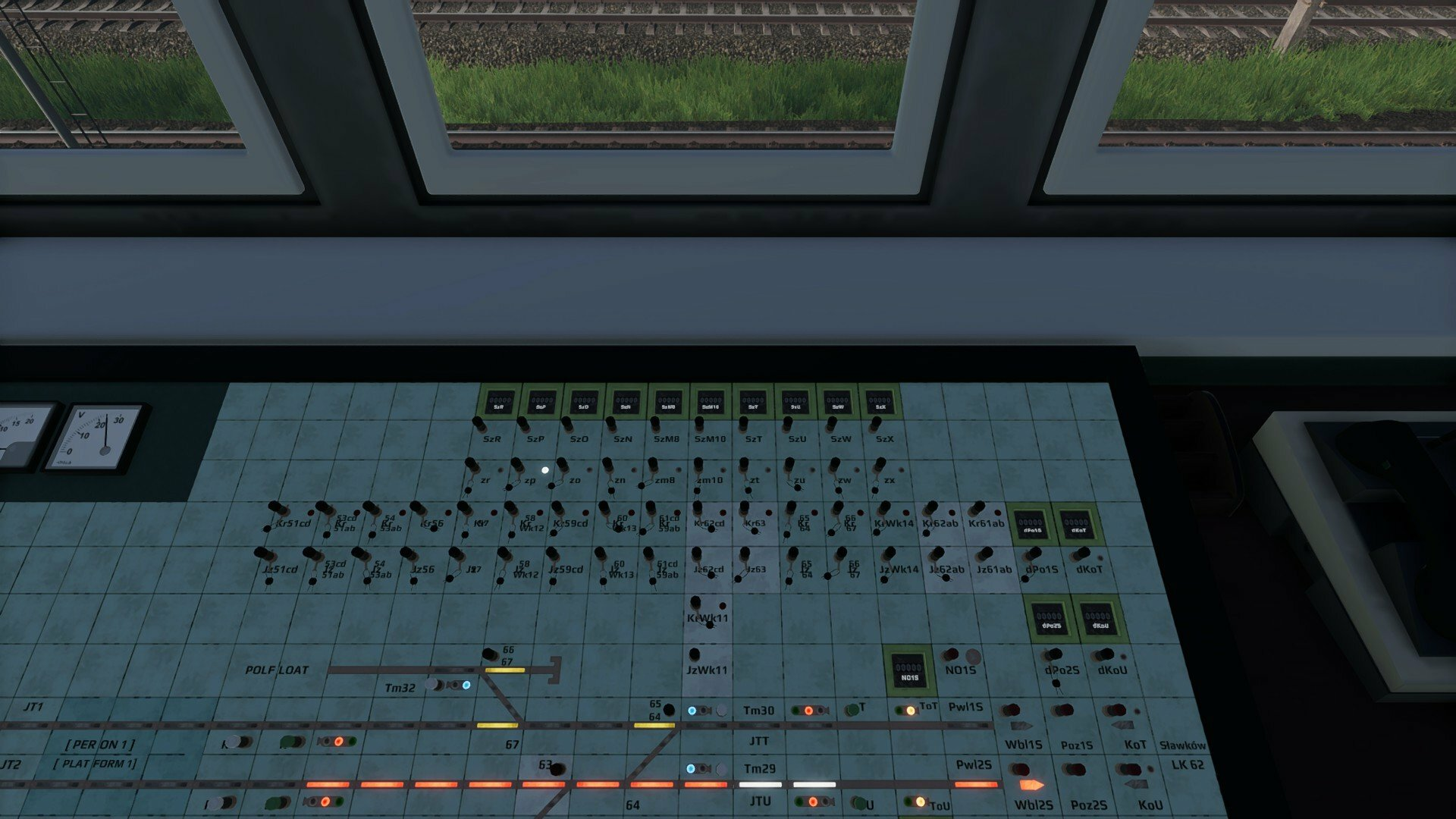
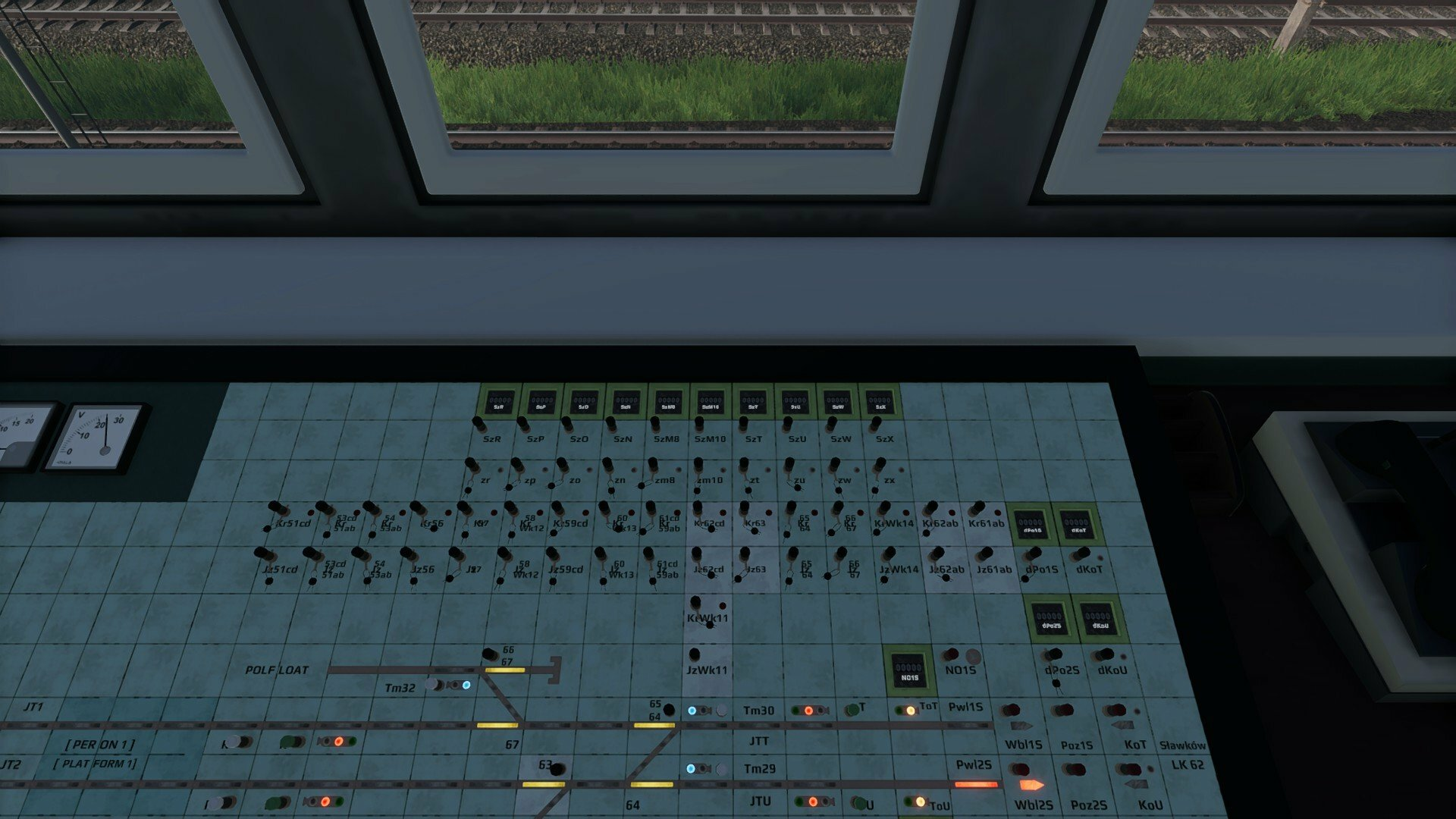
ATTENTION: If the exit signal cannot be set to clear, the procedure for the dPo operation is the same like for the C-type block! However, the effect of the operation is different: with the Eap design, the dPo button immediately switches the starter field indicator to red steady light (blocked). After our train has passed the block section, the train is blocked by the neighbouring signal box. The starter field indicator will flash white for a short time and disappear. The system automatically returns to its neutral default position. Line repeating interlock (Pwl) will become ineffective again until the next signal is cleared.
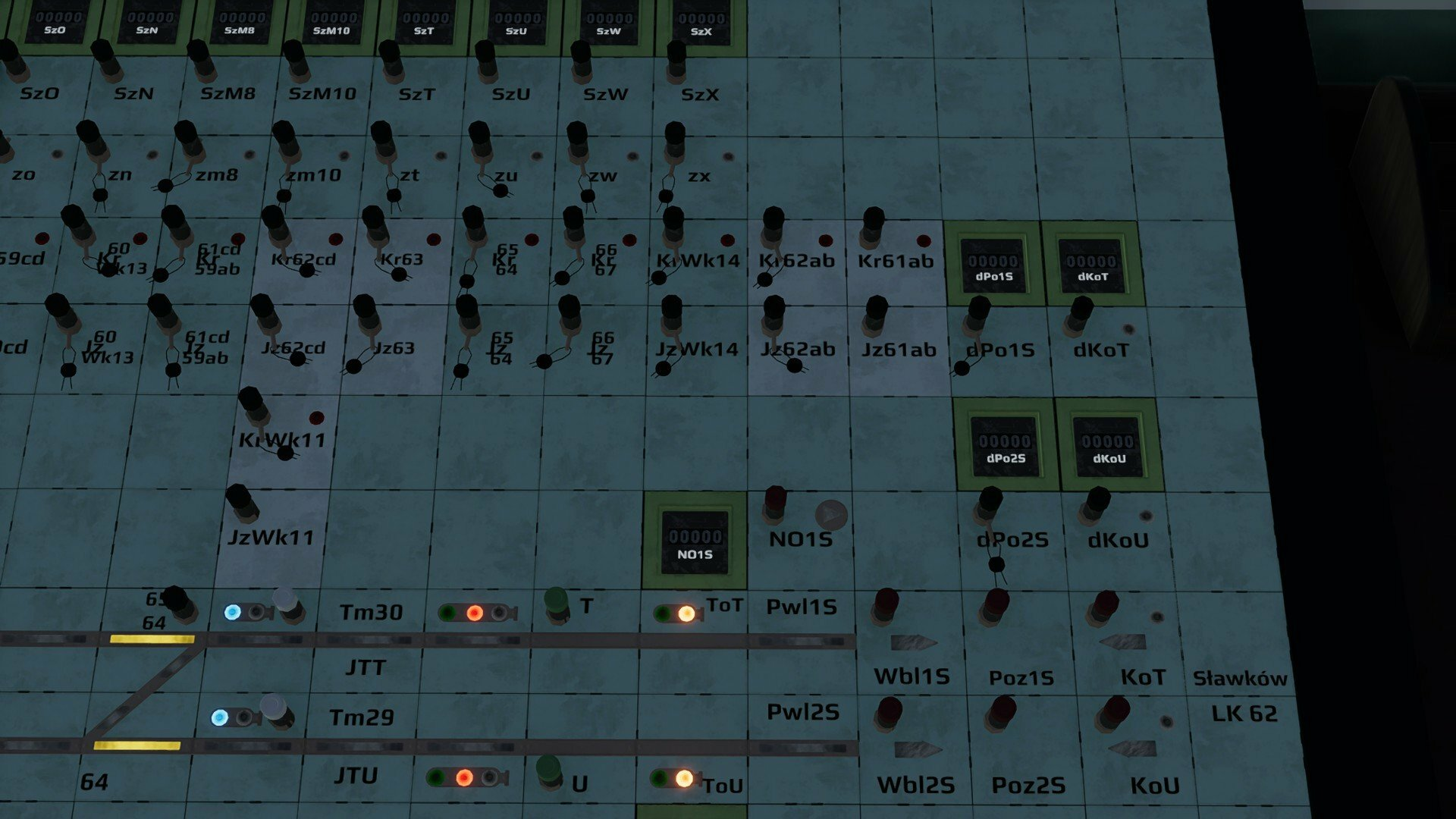
Train running from the neighbouring signal box to our signal box
Before the neighbouring signal box can release a train, it also has to bring the line block out of neutral. Permission is requested from us. This is indicated to us by the white flashing end field indicator. In case the neighbouring signal box does not require the clearance any more and we have not yet given permission, the request can be cancelled by the neighbouring signal box without further action and the end field indicator extinguishes again. Permission is granted by pressing the "Poz" button. The end field indicator will then display a white steady light.
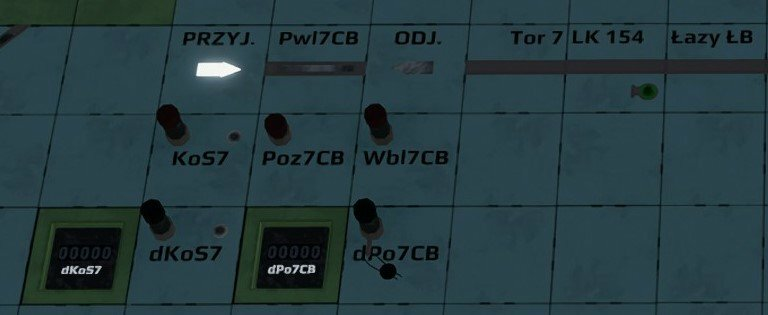
It is still possible to cancel the activation of the line block in case the train is no longer meant to come. The neighbouring signalman takes back their request first. Afterwards we have to pull the button "Wbl". The line block then changes back to the neutral default state. As soon as an exit signal in the neighbouring signal box is set to clear, the end field indicator displays a red flashing light. Once the train has passed the exit signal of the neighbouring signal box, the end field indicator changes to a red steady light.
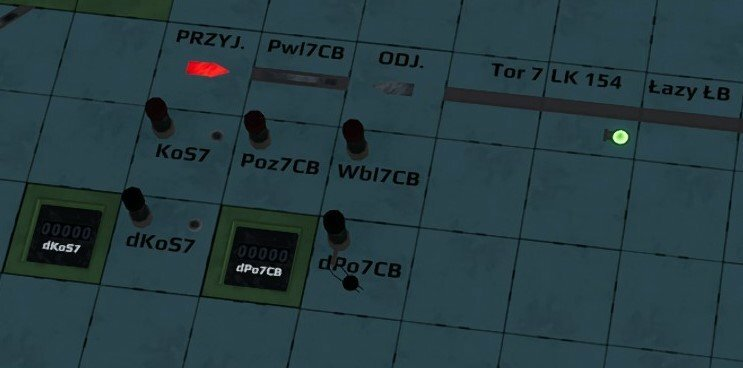
The trains has entered the block section. The end field indicator is steady red and the block section indicators show "occupied". Our signal has been set to clear already.
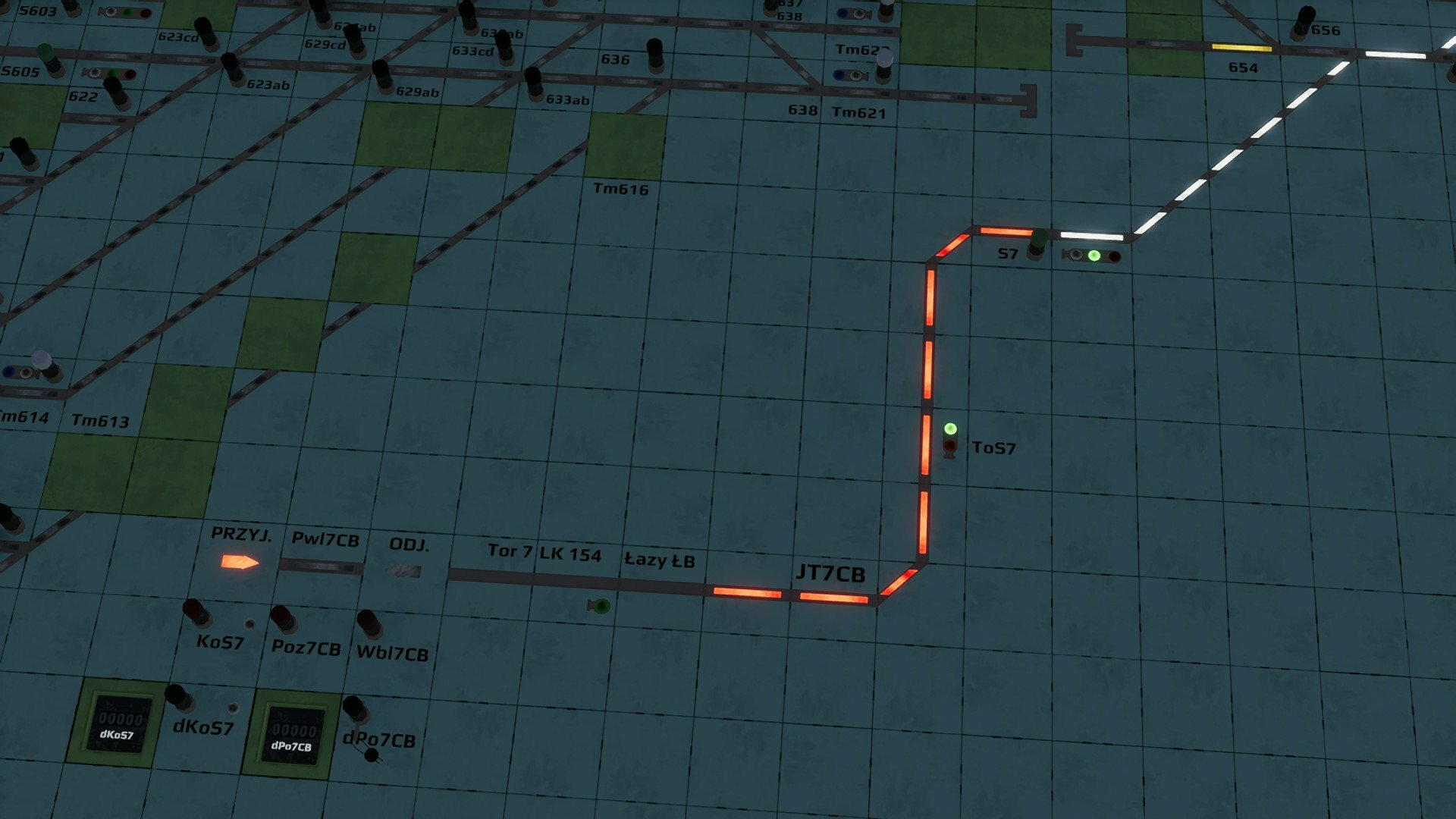
Once the train has been through the block section and passed our entry signal, it is time to clear the linie again so that we are ready to accept the next train. The conditions for clearing the line are exactly the same as for the relay block type C (see above).
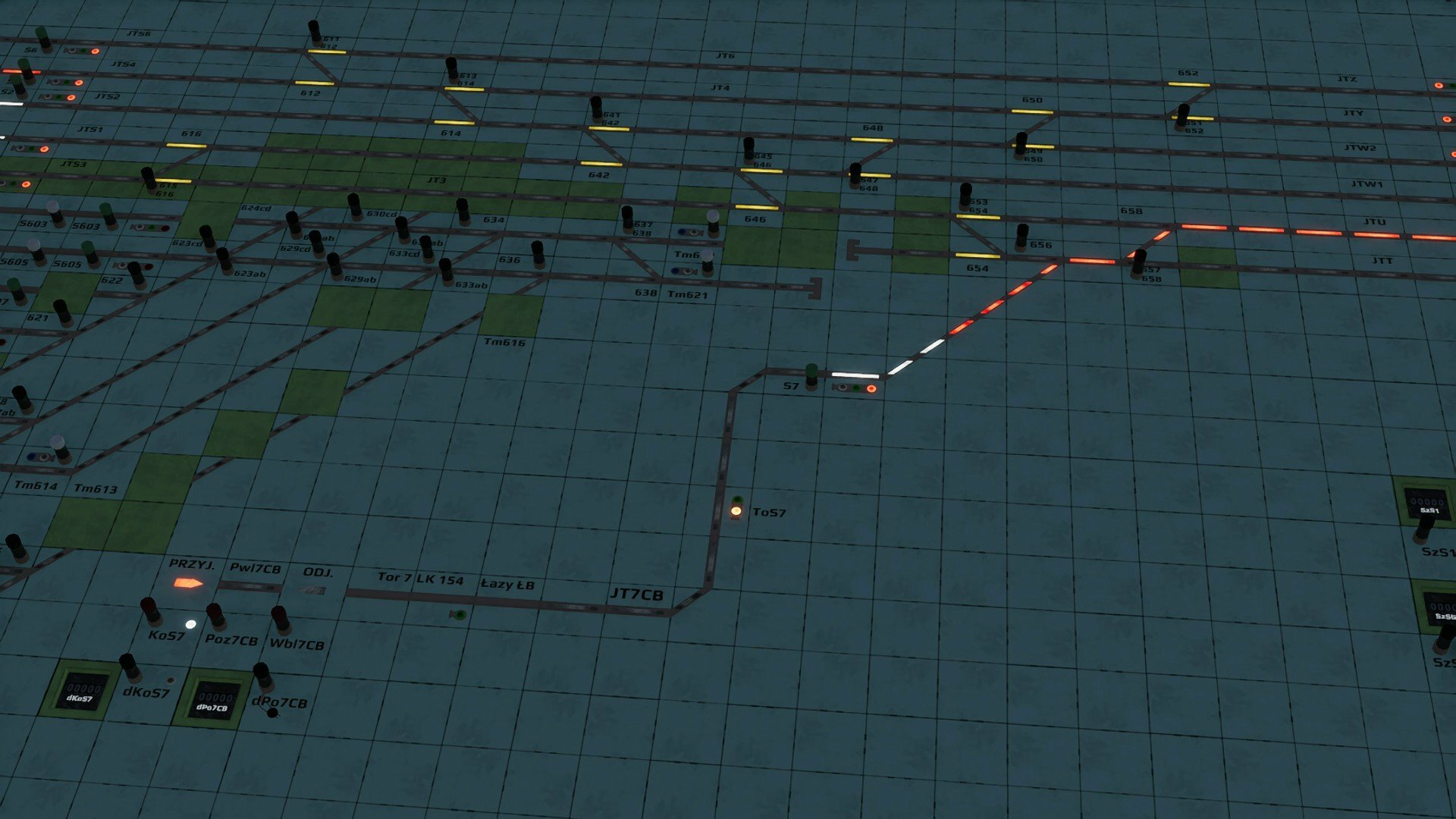
ATTENTION: If the entry signal cannot be set to clear, the same rules apply for the manual operation of the clearance detector (dKo) as for the C type relay block (see above). After the "Ko" button has been operated, the end field indicator starts white flashing and the line block then switches automatically to the neutral default position. The next train may then follow.
Automatic line block - samoczynna blokada liniowa (SBL)
In comparison to the non-automatic line block, the automatic line block operates without the involvement of the traffic controller. Here, the line block equipment also replaces the clearance check, which is now only necessary in the event of malfunctions or technical work. SBL is flexible in its use. It can be set up on single and double-track lines and can work with any type of interlocking (mechanical, electronic, relay). The systems automatically detect train movements with the help of track circuits or axle counters and thus determine whether the individual block sections are free. In addition, it is possible to set up automatic block signals along the line in order to increase the train density, which is the norm in Poland. But there are also automatic block lines without automatic block signals. The technology to control the SBL-Signals is usually located in a separate container next to the signals. SBL-Signals show "clear" as default position. SBL-Signal 2955 between Dąbrowa Górnicza Ząbkowice and Dąbrowa Górnicza. It displays S2 aspect (Clear). We can see another SBL-Signal of the opposite direction. In the background there is a relay container controlling both block signals.
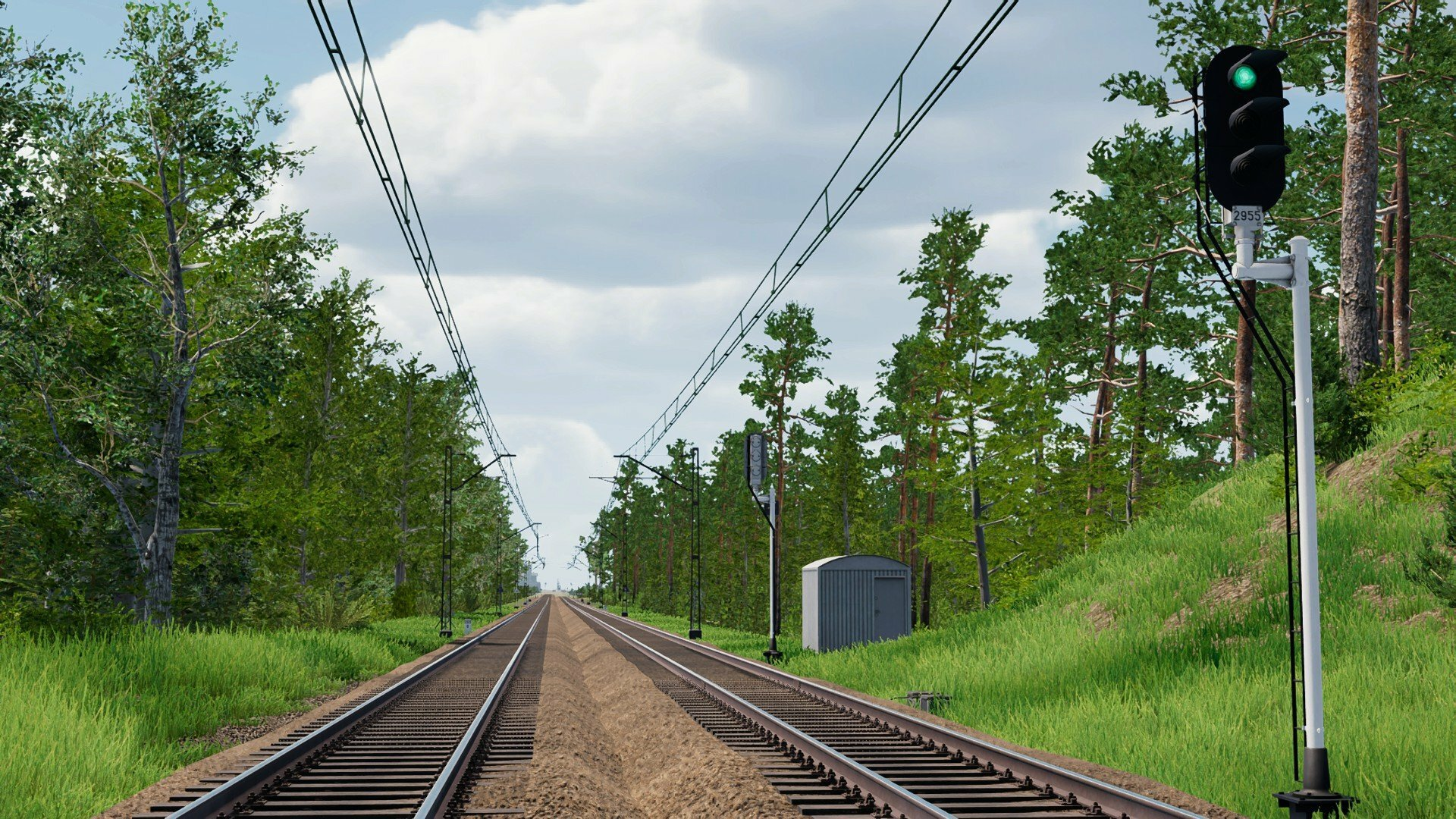
The automatic blocks signals themselves are always train-controlled and cannot be operated in the signal box. They are not equipped with a replacement signal. At the same time, the automatic block signals always have the functionality of a main and a distant signal at once. When an automatic block signal indicates "stop", the train may continue its journey at a maximum speed of 20 km/h on sight after stopping. Signaller's permission to pass the signal at danger is not required. On most SBL lines, a bidirectional operation is set up. This allows the direction of running to be changed and trains to run on the opposite track under regular signalling. SBL-Signal 3037 between Dąbrowa Górnicza and Będzin. It displays S5 aspect (Expect stop) and is equipped with a W18 board.
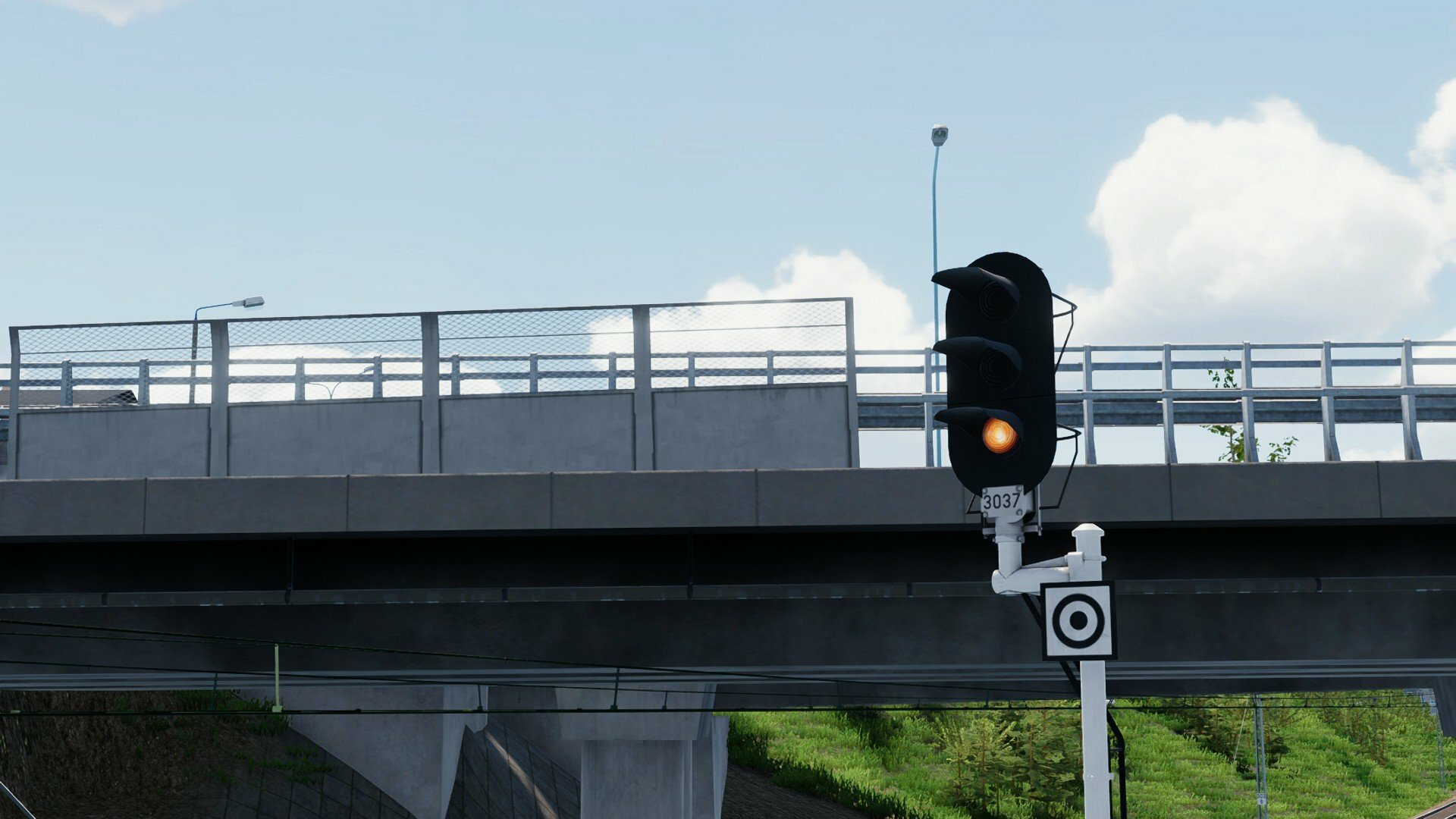
Automatic block signals that are set up against the current direction of the line are switched to dark. Exceptions are the automatic block signals equipped with signal W18, which will indicate a signal aspect even against the set running direction. Signal W18 means that the next main signal is operated by an interlocking. Signal W18 is a black circle on a white background with a black dot in the middle. The SBL signals are mounted on a grey mast to distinguish them from the interlocking-operated signals with white-red-white masts.
SBL type Eac
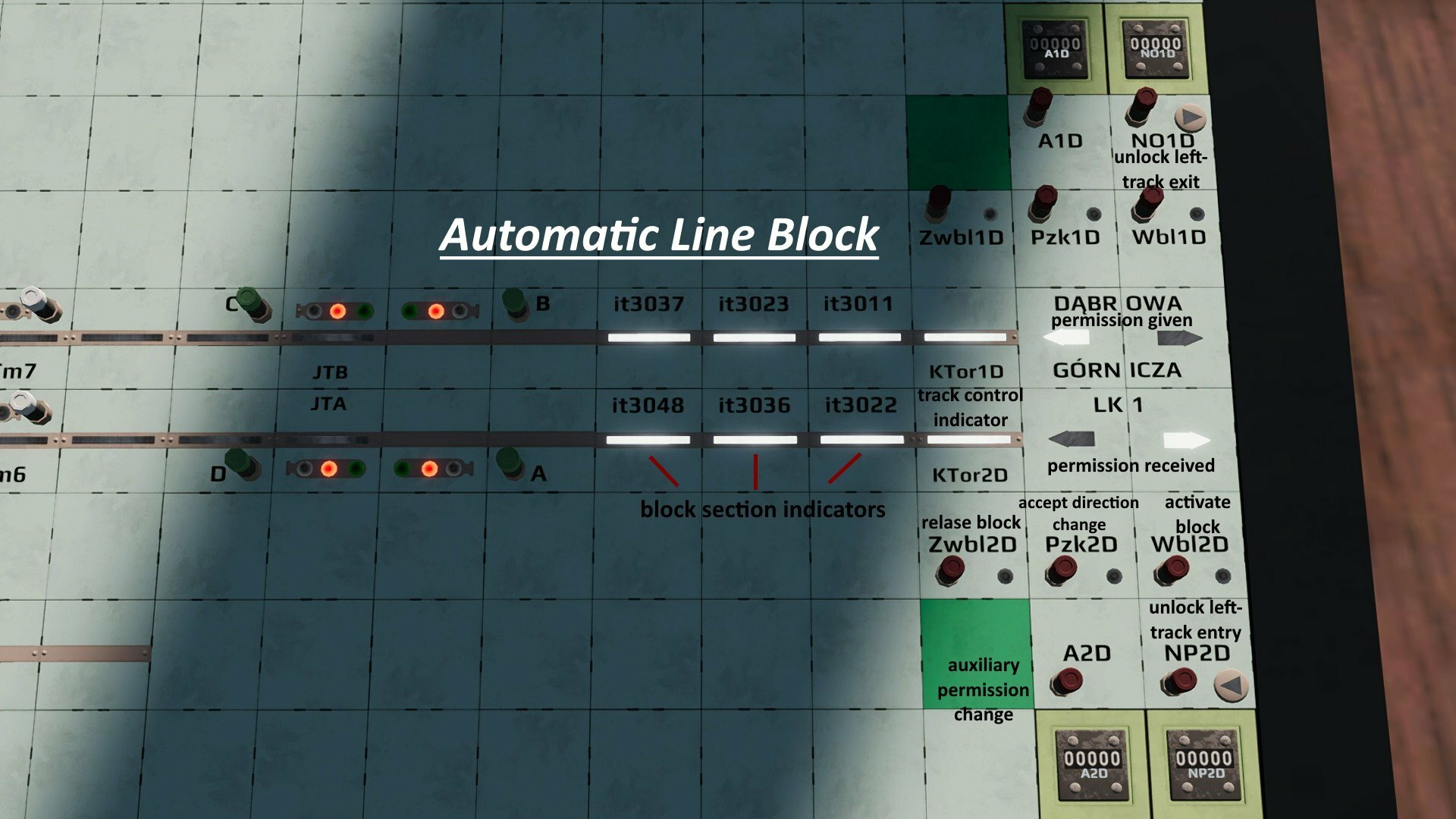
In Poland all used forms of SBL are very similar in operation and appearance.
Buttons and indicators
The track sections are illuminated in white in the default position and named according to the mileage of the line. The occupied indication is red. Buttons additionally bear the name of the track section and the initial letter of the neighbouring signal box (e.g. Wbl2D). The permission indicators are white and arrow-shaped. Wbl - włączenia blokady / activate block/release exit lock Zwbl - zwolnienia blokady / release block Pzk - przycisk zmiany kierunku / accept direction change A or AZK - awaryjnej zmiany kierunku / auxiliary permission change with counter NP - niewłasny przyjazd / unlock left-track entry with counter NO - niewłasny odjazd / unlock left-track exit with counter Ktor - Kontrola toru / track control indicator Stop - lock exit
Functionality
In this explanation, we assume that when entering the interlocking, the automatic block sections are clear and that the directions of running are regularly set on all track sections. When entering a signal box in SimRail, the state you find may of course differ. All track sections are illuminated in steady white light and the permission arrows also show steady white light in the regular direction of running. As soon as a automatic block section is occupied by a train, the block section indicator changes to steady red light. When a train is in motion, the red indicator moves with it according to the direction of travel. If automatic block signals are in place, they operate automatically and will display a matching signal aspect. In some panels, not each and every block section will be visible to us. Only some are displayed. On such lines, the signal boxes have a kind of general indicator marked "Ktor". This indicator lights up in the steady red light as soon as at least one block section between the interlockings is occupied. The picture shows four lines equipped with automatic block signalling and the track control indicator "kTor" in different states:
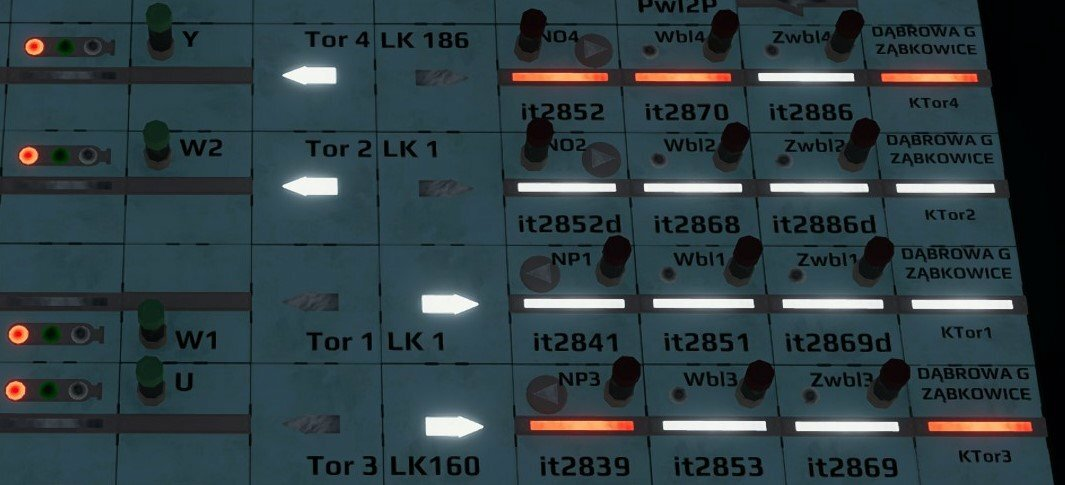
When setting routes, nothing else has to be considered, the equipment of the line block usually does not have to be operated and will work automatically. A main signal in the direction of the SBL line can be set to clear as soon as the first block section is indicated as clear. In addition, the reception of permission must also be indicated.
Changing directions
(Some pictures made by @Skully) The direction change is set up to prevent two trains from entering an automatic block line from both sides at the same time. On single-track lines with SBL, such a change of direction is mandatory. Most double-track SBL lines are also equipped with a change of direction, only a few SBL lines on double-track railways do not have a change of direction installed. On double-track SBL lines, a change of direction allows trains to run in the opposite track under full technical protection. Here, SBL signals are also set up at the same intervals as in the regular track. Train movements in the opposite track are controlled as usual under the clear aspects of main signals. When entering the opposite track, the signal W24 is indicated at the interlocking-controlled main signal. Driving on the left track can be used to accelerate the operational flow (e.g. overtaking on the run). In addition, the permanently installed change of direction simplifies operations during construction work, track closures, broken down trains, disruptions, etc. that only affect one track. The change of direction is possible when the arrival permission indicator is lit in white. To do this, the Zwbl button must be pulled. The line block now checks whether:
- all block sections between the signal boxes are free
- an exit into the automatic block line has been set.

If all block sections are free and no exit to the line has been set, the arrival permission indicator starts flashing. Now all automatic block signals are switched dark with the exception of the signals with W18 board. When this is done, the arrival permission indicator goes off and the block section indicators flash white. The line block has now entered the neutral state.

The new direction of travel can be requested with the Wbl button. The block section indicators continue to flash white, in addition the departure permission indicator now flashes. The neighbouring signal box must now cooperate and agree to the change of direction. As soon as this has happened, the departure permission indicator and all block section indicators light up in steady white light. The direction of run has now been changed and a train can be released. If a train is now to be let into the opposite track, the corresponding "NO" button for the left track must be operated. As long as the "NO" operation is active, the indicator next to the button lights up white. If a replace signal (Sz) on the station side is operated while the "NO" indicator is lit, the opposite track indicator W24 is also switched on.
Train leaving Bedzin for Sosnowiec Glowny on the left track. Signal K2 displays S6 aspect (Clear with 100kph, expect clear) in combination with W24 (route is set to the left track).
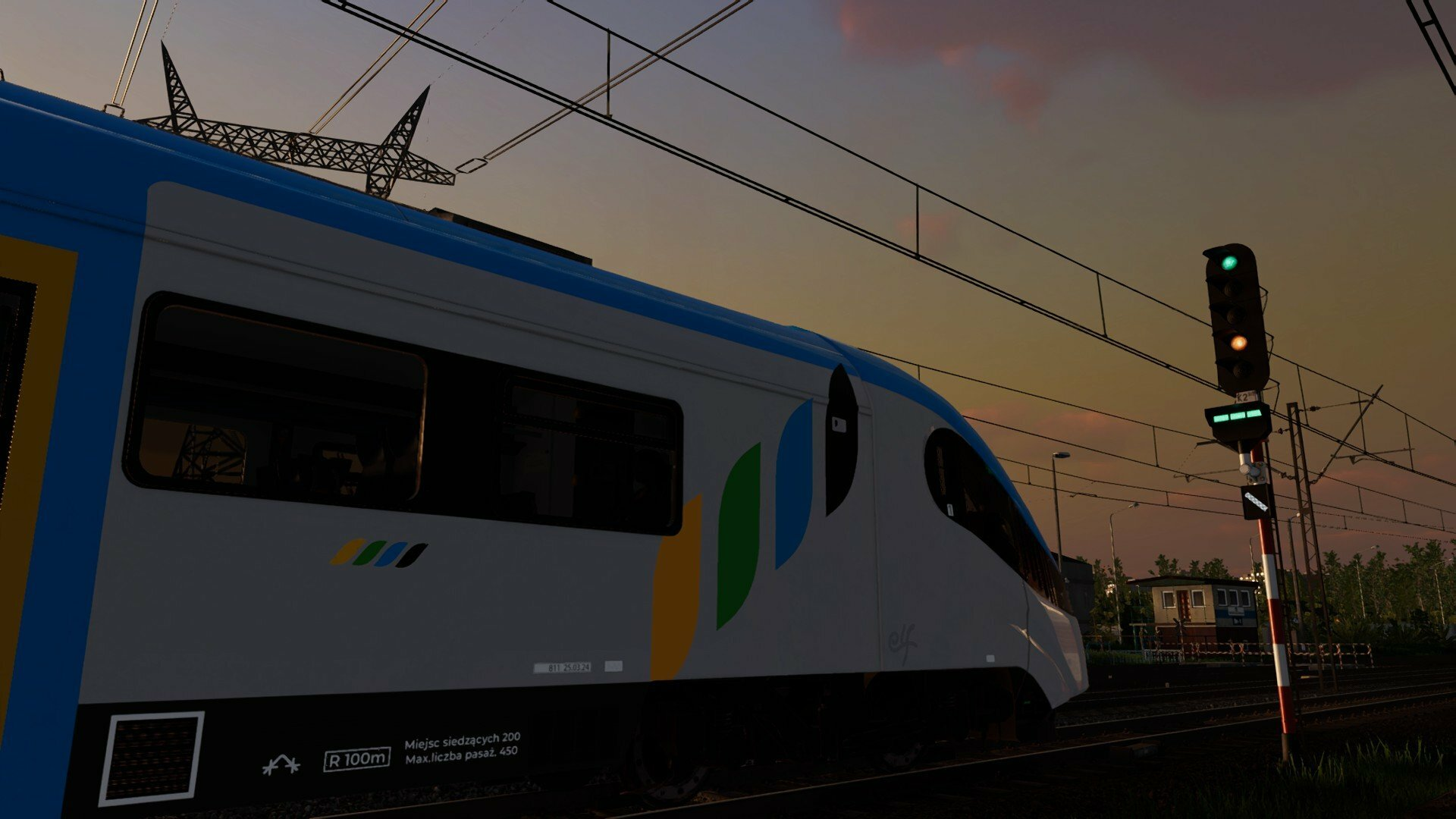
If a train is to be accepted on the opposite track or we want to agree to a requested change of direction, the "Pzk" button is operated. When the arrival permission indicator flashes, the change of direction can be accepted. The SBL signals of the new direction are switched on and the neighbouring signal box can release a train.
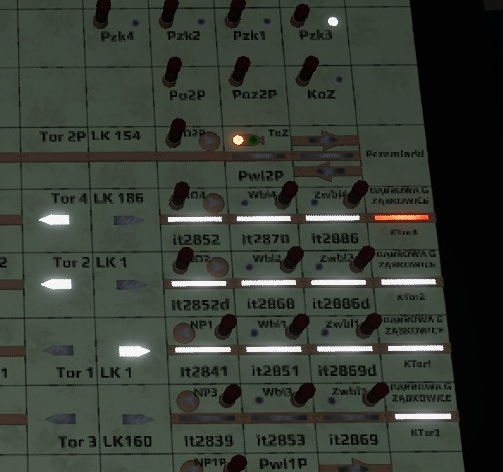
If a train is to be accepted from the left track, there can also be an "NP" button in the interlocking. However, this is not available in every interlocking. In case this button is installed, the corresponding entry signal can only be set to clear after it has been operated. As long as the "NP" operation is effective, no exit can be set into the corresponding track. The effectiveness of the "NP" operation is indicated by the indicator light next to the button.

Exit lock
Pressing the STOP button while departure permission is displayed will enter a lock into the system that will prevent the setting of an exit into the corresponding track. This operation can be used, for example, during track closures. The departure permission indicator changes to a steady red after operation. The exit lock can be deleted by pressing the Wbl button; the departure permission indicator changes back to steady white light. The STOP button is optional and not installed in every system. If the permission has been changed auxiliary (see below), the track is also in the blocked state after the change of direction. In this case, the locking effect must also be released with Wbl. This is also the case even if no STOP button is installed in the interlocking.
Auxiliary change of direction
Interlockings with longer lines optionally have the possibility to change the permission in an auxiliary way. This auxiliary action is used if the regular change of direction cannot be used due to a malfunction. This can be the case, for example, if an automatic block section is displayed as occupied due to a technical malfunction. The interlocking on which the departure permission is indicated can carry out the auxiliary change of direction. To do this, the "A" or "AZK" button must be pulled. Now the direction of run on the line changes without the neighbouring signal box's involvement. Meanwhile, the arrival permission indicator flashes red. After the change of direction has been completed, the light changes to white. The neighbouring signal box, which now has the permission, must press the "Wbl" button in order to release the lock of the line. It is automatically activated as soon as the neighbouring signal box has changed the permission auxiliary. Now the neighbouring signal box can release a train. If there are trains running on the opposite track, "NO" or "NP" must be used here as well.
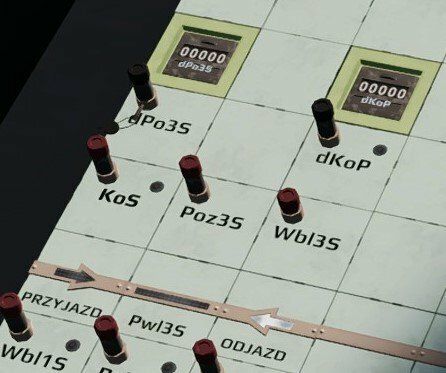
Author of this guide: Oli806. Copied with permission from the author.